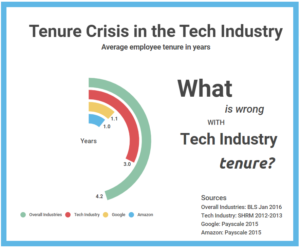I am seeing a growing number of tech and other services companies in Indianapolis with zero, or very few (less than 10%), employees who are 45 or older- even in larger companies with over 50 employees. If that is you, then that makes your company a one generation, one dimension (or “one gen/one dim”) workforce- and that can be dangerous.
According to STATSINDIANA, Indiana’s older population (age 45+) represents 53.8% of the age 18+ population, while the 18-44 span represents 46.2% of the population. And if we project this represents the current work force, then over half of the employees at an average company are ages 45 and up.
Even comparing only young adult’s (25-44) 1,674,571 population to older adult’s (45-64) 1,730,213, older workers still represent 50.8%, over half.
If your demographics are not anywhere close to that, then why not?
And Indianapolis, it’s not just you. I’ve read that Silicon Valley and other tech hubs are just as guilty.
One thing that seems to be impacted by a one gen/one dim workforce may be the average length of time at an employer. Tenure is the average duration of employment. It is NOT a synonym for dead wood.
According to the Bureau of Labor Statistics, average tenure in all industries in 2016 for employees ages 25 to 34 was 2.8 years, while the tenure of employees age 55 to 64 was 10.1 years. That’s a three time difference!

You can see by the above graphic that the average tenure in the tech industry is only three years, compared to 4.2 years overall. And it is getting shorter. Google’s tenure is 1.1 years and has one of the youngest work forces in the industry (averaging around 29 years old). Ironically, they are being sued in a class action case for age discrimination. Is there a correlation between tenure and age, or are there other factors in play?
How does low tenure impact the tech industry? According to the Society for Human Resource Management, the average cost per hire for companies in 2015 is $4129, taking nearly 42 days to fill the position. That doesn’t include the cost of ramp up time for training, lost productivity, etc, which could add as much as the entire one year salary to the “cost of replacing an employee”.
If your tenure is anywhere close to the industry average for tech, that is a tremendous amount of money wasted simply on replacing lost employees.
Can a multi-generational workforce work together? Of course! That has been a truism for eons. As for me, I have led multi-generational teams ranging from 21 to 62 in both the insurance and technology fields. It really works, but it takes leadership, vision, clear team expectations, and an effective performance improvement plan in place to make it work well – just as you would with a one gen/one dim workforce.
And finally, at the risk of jumping up and down on a live land mine, the final concern about the older workforce is, “Do they even get it? I mean, the younger workforce gets the internet, and all of the high technologies associated with it. The older generation may not get it.” Well, first of all, it is the older generation that invented the internet, the cell phone, HUD, holograms, and so on.
In a 2017 article written by Wolf Richter titled “Tech workers get better with age”, he quotes a Visier Insights report that essentially concludes that the proportion of Top Performer rankings in Tech increases with age, and that maturity and experience are more important drivers of high performance in Tech than non-Tech. That would seem obvious, right?
Yet, Tech hires a much higher proportion of younger workers and for existing tech employees, there is a sizable “promotion based on performance” disconnect for older workers.
So how do you know if you are hiring based on qualifications, and not on age? Simple. Start by auditing the past three to five job hires. Review the candidates who submitted for the positions, then do a deeper dive into the ones who were qualified on paper- which means, if your job description says “a minimum of 2 years of sales experience”, then candidates with 10 years meet that description and are technically qualified. You get the idea.
Then look at the list of “technically qualified”. How many were called for a phone screen, and why them and not the others? Why was the person who was hired, selected?
Then ask, “Was that person the most qualified person based on the education, skills and perceived value to the team?”
In your sample audit, if you find irregularities and you can’t honestly answer the above question, then it is time to do a deeper dive into your hiring practices. After all, the objective is to hire the most qualified available talent, right?
In my opinion, and based on a long history of work experience, if the older, qualified talent is not currently in your talent pool, then you are missing out on an incredible opportunity to take advantage of the valuable experience, education, and skills that the traditionally loyal older worker has to offer.
Don’t get me wrong. I hate the “we’ve always done it that way” mentality, and I really dislike dead wood employees who milk the system. I align more with the “let’s try it and see” approach, which is something I see more with the younger generation. So, what do you say, those of you in the tech industry?
Hire based on qualifications, not age. Let’s try it and see.






Recent Comments